Never miss another geomagnetic storm. Sign up for Space Weather Alerts
and you'll receive a text message when magnetic storms erupt. Aurora
tour guides and professional astronomers use this service. You can, too!
|
|
|
SEVERE GEOMAGNETIC STORM: Forecasters did not see this one coming. On March 23-24, auroras spread into the United States as far south as New Mexico (+32.8N) during a severe (category G4)
geomagnetic storm--the most intense in nearly 6 years. The cause of
the storm is still unclear; it may have been the ripple effect of a
near-miss CME on March 23rd.
"Aurora pillars were visible
from Shenandoah National Park in Central Virginia," says Peter Forister,
who photographed the light show at latitude +38.7 degrees:
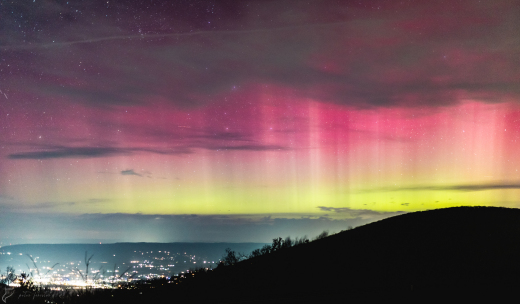
"Beautiful red and green
colors were visible to the naked eye around 11 pm local time," he says.
Other notable low-latitude sightings were made in Colorado (+38.7N), Missouri (+40.2N), Colorado again (+38.3N), Nebraska (+41N) and North Carolina (+36.2N). More than half of all US states were in range of the display.
Not every light in the sky was the aurora borealis, however. There was also STEVE:
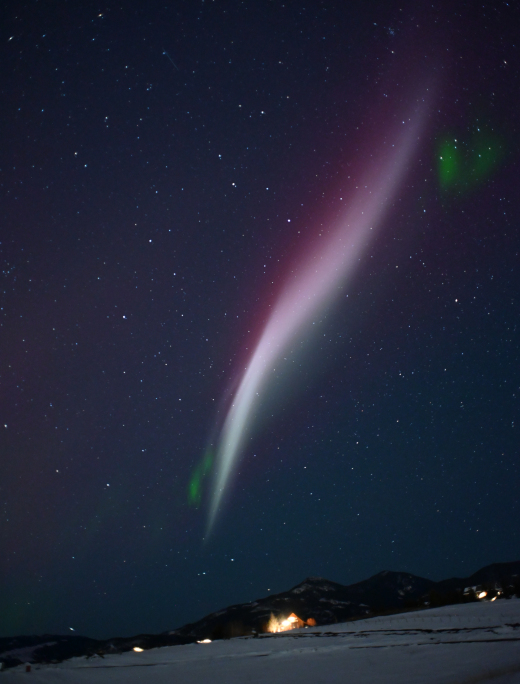
Joseph Shaw photographed the luminous ribbon over Bozeman, Montana. It also appeared over South Dakota, Washington State, Idaho, Montana again, and Scotland.
STEVE (Strong Thermal Emission Velocity Enhancement) looks like an aurora, but it is not.
The phenomenon is caused by hot (3000°C) ribbons of gas flowing
through Earth’s magnetosphere at speeds exceeding 6 km/s (13,000 mph).
These ribbons appear during strong geomagnetic storms, revealing
themselves by their soft purple glow.
This remarkable and surprising
storm began on March 23rd when magnetic fields in the space around
Earth suddenly shifted. In the jargon of space weather forecasting "BsubZ tipped south." South-pointing magnetic fields can open a crack in Earth's magnetosphere and, indeed, that's what happened. Earth's "shields were down" for almost 24 hours, allowing solar wind to penetrate and the storm to build to category G4.
These developments may have
been caused the close passage of an unexpected CME. The storm cloud
could have left the sun on March 20-21 when SOHO coronagraph data were
unusually sparse. We didn't know it was coming. For aurora watchers, it
was a welcome surprise. Aurora alerts: SMS Text.
Realtime Aurora Photo Gallery
Free: Spaceweather.com Newsletter
AMBER BUMBLEBEE SPACE PENDANT: Bumblebees don't usually fly so high. On Oct 15, 2022, the students of Earth to Sky Calculus launched this one to the stratosphere onboard a cosmic ray research balloon. Here it is floating 115,158 feet above California's Sierra Nevada:
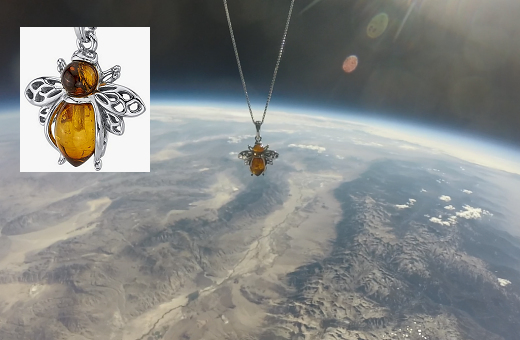
You can have it for $179.95.
This bee is made of genuine Baltic Amber with a sterling silver
exoskeleton. The rich Cognac-colored pendant measures 3/4 inch and comes
with a matching 18-inch sterling silver chain.
The students are selling
these unique pendants to support their cosmic ray ballooning
program. Each one comes with a greeting card showing the bumblebee
in flight and telling the story of its trip to the stratosphere and
back again.
Far Out Gifts: Earth to Sky Store
All sales support hands-on STEM education
A SOLAR RADIO BURST AT NIGHT: Something
rare and strange happened last month. On Feb. 23rd, growing sunspot
AR3234 produced an M-class solar flare. It was nearly midnight in
Florida when the explosion occurred, so you'd expect no one there to
notice. On the contrary, in the community of High Springs, FL, amateur
radio astronomer Dave Typinski recorded a strong shortwave radio burst.
"You CAN see the sun at midnight in Florida... sometimes," says Typinski. This is what his instruments recorded while the flare was underway:
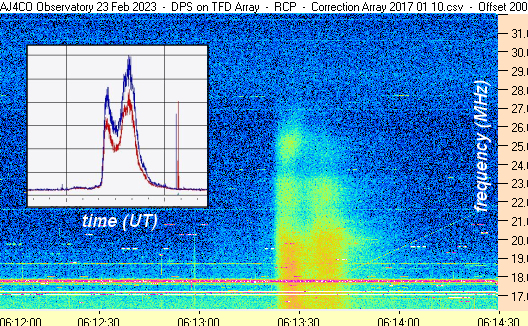
A double wave of static washed
over Florida, filling the radio spectrum with noise at all frequencies
below 25 MHz. "The Sun was 69° below the horizon when this happened,"
he marvels.
How is this possible? The entire body of our planet was blocking the event from Typinski's antenna. It's called "antipodal focusing."
First postulated by Marconi more than 100 years ago, antipodal focusing
is a mode of radio propagation in which a signal starts out on one side
of the planet, gets trapped between Earth's surface and the
ionosphere, and travels to the opposite hemisphere. Waves converging at
the antipode can create a surprisingly strong signal.
 Right: This diagram from a declassified US Gov.report shows the basic geometry of antipodal focusing.
Right: This diagram from a declassified US Gov.report shows the basic geometry of antipodal focusing.
"This is the second or maybe third midnight solar radio burst I've seen in ten years, but it's by far the strongest," says Typinski. "The previous events happened at the height of Solar Cycle 24. They're quite rare."
Pause: Yes, solar flares can produce radio signals. Typinski's midnight burst was a "Type V,"
caused by streams of electrons shooting through the sun's atmosphere in
the aftermath of the flare. Plasma waves rippling away from the streams
emited intense bursts of natural radio static. The burst was first
observed in broad daylight at the Learmonth Solar Observatory in
Australia, then it curved around Earth to reach Typinski.
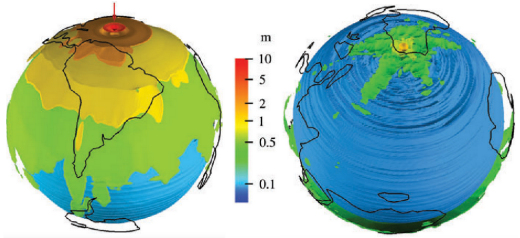
Above: An
example of antipodal focusing of seismic waves caused by the Chicxulub
asteroid impact. The geometry is the same as for radio waves. [more].
"This propagation mode was
used during the Cold War," notes Typinski. "The U.S. would park a SIGINT
ship in the south Pacific to grab signals from the Eastern Bloc. The
Soviets probably did the same thing, parking in the southern Indian
ocean."
Turns out, this method of spying works for radio astronomers, too. Would you like to record an event like this? NASA's Radio JOVE program makes it easy. Off-the-shelf radio telescope kits allow even novices to monitor radio outbursts from the sun, which are becoming more frequent as Solar Cycle 25 intensifies.
Realtime Space Weather Photo Gallery
Free: Spaceweather.com Newsletter
Realtime Aurora Photo Gallery
Free: Spaceweather.com Newsletter
Every night, a network
of
NASA
all-sky cameras scans the skies above the United
States for meteoritic fireballs. Automated software
maintained by NASA's Meteoroid Environment Office
calculates their orbits, velocity, penetration depth
in Earth's atmosphere and many other characteristics.
Daily results are presented here on Spaceweather.com.
On Mar 23 2023, the network reported 4 fireballs.
(4 sporadics)
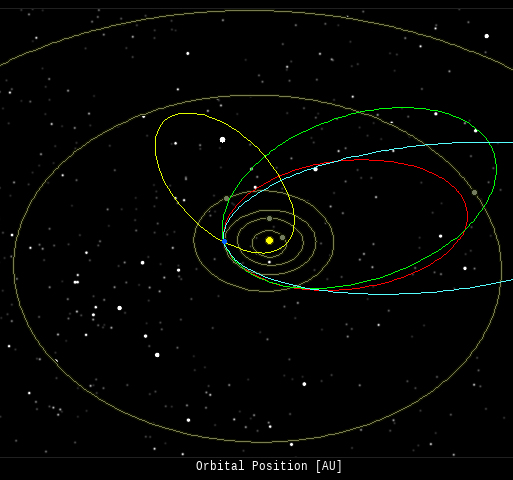
In this diagram of the inner solar system, all of the fireball orbits intersect at a single point--Earth. The orbits are color-coded by velocity, from slow (red) to fast (blue).
[Larger image] [movies]
Potentially Hazardous Asteroids (
PHAs)
are space rocks larger than approximately 100m that
can come closer to Earth than 0.05 AU. None of the
known PHAs is on a collision course with our planet,
although astronomers are finding
new
ones all the time.
On March 25, 2023 there were 2329 potentially hazardous asteroids.
 |
Recent
& Upcoming Earth-asteroid encounters:
| Asteroid |
Date(UT) |
Miss Distance |
Velocity (km/s) |
Diameter (m) |
| 2023 FO |
2023-Mar-19 |
0.9 LD |
6.2 |
5 |
| 2016 WH |
2023-Mar-19 |
18.1 LD |
11.8 |
14 |
| 2023 EV2 |
2023-Mar-20 |
4.6 LD |
13.2 |
21 |
| 2023 FV1 |
2023-Mar-21 |
4.9 LD |
13.8 |
9 |
| 2018 FE3 |
2023-Mar-21 |
10.1 LD |
5.4 |
13 |
| 2023 FL3 |
2023-Mar-21 |
5.4 LD |
9 |
15 |
| 2023 FR3 |
2023-Mar-22 |
20.1 LD |
16.2 |
234 |
| 2023 FT |
2023-Mar-22 |
13.4 LD |
10.8 |
37 |
| 2023 FD3 |
2023-Mar-22 |
8.1 LD |
11.3 |
15 |
| 2023 FG |
2023-Mar-23 |
1.8 LD |
10.8 |
11 |
| 2023 FK1 |
2023-Mar-23 |
4.8 LD |
13.4 |
16 |
| 2023 EO1 |
2023-Mar-23 |
6.8 LD |
21.1 |
45 |
| 2023 EF2 |
2023-Mar-23 |
10 LD |
14.2 |
26 |
| 2023 FA |
2023-Mar-23 |
3.1 LD |
8.7 |
18 |
| 2023 FT2 |
2023-Mar-24 |
7 LD |
12 |
22 |
| 2023 DZ2 |
2023-Mar-25 |
0.5 LD |
7.8 |
52 |
| 2023 FL2 |
2023-Mar-26 |
12.2 LD |
6.1 |
21 |
| 2023 DX2 |
2023-Mar-27 |
8.5 LD |
9 |
53 |
| 2023 FW2 |
2023-Mar-27 |
3.2 LD |
8.7 |
9 |
| 2023 FZ2 |
2023-Mar-27 |
3.6 LD |
12.2 |
17 |
| 2019 FT |
2023-Mar-27 |
17.1 LD |
28.2 |
93 |
| 2022 YK4 |
2023-Mar-29 |
11.9 LD |
2.3 |
25 |
| 2023 FR1 |
2023-Mar-30 |
19 LD |
7.9 |
42 |
| 2023 EK2 |
2023-Mar-30 |
12.9 LD |
15.4 |
89 |
| 2017 SE12 |
2023-Mar-30 |
5.2 LD |
8.4 |
15 |
| 2016 GH1 |
2023-Mar-30 |
7.7 LD |
5.8 |
11 |
| 2023 FO3 |
2023-Mar-31 |
6.6 LD |
10.2 |
16 |
| 2022 GO3 |
2023-Apr-02 |
17 LD |
11.6 |
15 |
| 2021 GN1 |
2023-Apr-02 |
17.7 LD |
14.2 |
18 |
| 2023 FM |
2023-Apr-06 |
7.9 LD |
15.9 |
171 |
| 2018 FD |
2023-Apr-07 |
17.9 LD |
8.2 |
47 |
| 2023 FT1 |
2023-Apr-10 |
19.6 LD |
6.6 |
31 |
| 2019 GK21 |
2023-Apr-13 |
15.2 LD |
8.1 |
27 |
| 2022 YK9 |
2023-Apr-13 |
19.9 LD |
9.9 |
175 |
| 436774 |
2023-Apr-13 |
12.5 LD |
17.6 |
719 |
| 2006 HV5 |
2023-Apr-26 |
6.3 LD |
17.4 |
400 |
| 2021 JF2 |
2023-Apr-28 |
16.6 LD |
8 |
19 |
| 2018 VS6 |
2023-May-01 |
5.2 LD |
11.6 |
14 |
| 2011 KY15 |
2023-May-18 |
19.9 LD |
14.3 |
54 |
| 2021 JK7 |
2023-May-22 |
16.7 LD |
22.9 |
48 |
 |
Notes: LD means
"Lunar Distance." 1 LD = 384,401 km, the distance
between Earth and the Moon. 1 LD also equals 0.00256
AU.
| |
Cosmic Rays in the Atmosphere |
SPACE WEATHER BALLOON DATA: Almost once a week, Spaceweather.com and the students of Earth to Sky Calculus
fly space weather balloons to the stratosphere over California. These
balloons are equipped with sensors that detect secondary cosmic rays, a
form of radiation from space that can penetrate all the way down to
Earth's surface. Our monitoring program has been underway without
interruption for 7 years, resulting in a unique dataset of in situ atmospheric measurements.
Latest results (July 2022): Atmospheric radiation is decreasing in 2022. Our latest measurements in July 2022 registered a 6-year low:
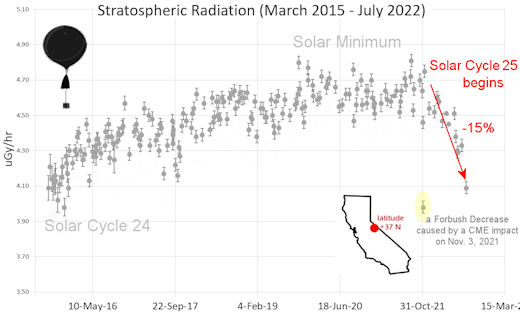
What's going on? Ironically, the radiation drop is caused by increasing solar activity. Solar Cycle 25 has roared to life
faster than forecasters expected. The sun's strengthening and
increasingly tangled magnetic field repels cosmic rays from deep space.
In addition, solar coronal mass ejections (CMEs) sweep aside cosmic
rays, causing sharp reductions called "Forbush Decreases." The two effects blend together to bring daily radiation levels down.
.Who
cares? Cosmic rays are a surprisingly "down to Earth" form of space
weather. They can alter the chemistry of the atmosphere, trigger lightning, and penetrate commercial airplanes. According to a study
from the Harvard T.H. Chan school of public health, crews of
aircraft have higher rates of cancer than the general population. The
researchers listed cosmic rays, irregular sleep habits, and chemical contaminants as leading risk factors. A number of controversial studies (#1, #2, #3, #4) go even further, linking cosmic rays with cardiac arrhythmias and sudden cardiac death.
Technical notes: The radiation sensors onboard our helium balloons detect X-rays and gamma-rays in the energy range 10 keV to 20 MeV. These energies span the range of medical X-ray machines and airport security scanners.
Data points in the graph labeled "Stratospheric Radiation" correspond to the peak of the Regener-Pfotzer maximum,
which lies about 67,000 feet above central California. When cosmic
rays crash into Earth's atmosphere,
they produce a spray of secondary particles that is most intense at
the entrance to the stratosphere. Physicists Eric Regener and Georg
Pfotzer discovered the maximum using balloons in the 1930s and it is what we are measuring today.
| |
The
official U.S. government space weather bureau |
| |
The
first place to look for information about sundogs,
pillars, rainbows and related phenomena. |
| |
Researchers
call it a "Hubble for the sun." SDO
is the most advanced solar observatory ever. |
| |
3D
views of the sun from NASA's Solar and Terrestrial
Relations Observatory |
| |
Realtime
and archival images of the Sun from SOHO. |
| |
information about sunspots based on the latest NOAA/USAF Active Region Summary |
| |
current counts of failed and deployed Starlink satellites from Jonathan's Space Page |
| |
Authoritative predictions of space junk and satellite re-entries |
| |
from
the NOAA Space Environment Center |
| |
fun to read, but should be taken with a grain of salt! Forecasts looking ahead more than a few days are often wrong. |
| |
from the NOAA Space Environment Center |
| |
the
underlying science of space weather |
 |
Getting YouTube comments is essential if you want to beat the algorithm! That’s why you need to buy YouTube comments from RealSocialz.com because they offer real USA comments you can customize. |
 |
BestCSGOGambling is the best site for everything related to CSGO gambling on the web |
 |
To find reviews of new online casino sites in the UK try The Casino DB where there are hundreds of online casino reviews complete with bonuses and ratings. Alternatively, Online-Casinos.xyz is another massive directory of online casinos listing sites for the UK and Worldwide.
Casinos that offer Rupees for bonuses are very generous to Indian players. Find the best online casinos in India at AllCasinos.in
Looking for a new online casino? Try Casimpo the new site dedicated to making online casino simple, or check out the new Avenger Slots Casino and Ace Online Casino with over 500 online slots and casino games. |
 |
When looking for casinos to play online when the weather is bad, you can try casino online trucchi
for Italian games. If you are not from Finland you can try the
Swedish page Svenska casino online to find suitable games, check out svenskacasinoonline.net. Always check your local laws before playing with real money. |
 |
Looking for sports betting companies not registered on GamStop? CasinoGap has presented a list of sites not on GamStop available for UK players. Check and bet online!
Would you like to bet at sites not using GamStop? Look at a list of NonStopCasino sites for online betting that aren't on GamStop. Top-rated bookmakers ever! |
| |
These links help Spaceweather.com stay online. Thank you to our supporters! |




No comments:
Post a Comment